Slotted Antenna Array with Enhanced Radiation Characteristics for 5G 28 GHz Communications
Abstract
:1. Introduction
2. Antenna Design
2.1. Single Element Antenna
2.2. 1 × 2 Sub-Array
2.3. 1 × 4 Antenna Array
3. AMC Layer for Gain Improvement
4. Results and Discussion
5. Conclusions
Author Contributions
Funding
Institutional Review Board Statement
Informed Consent Statement
Data Availability Statement
Conflicts of Interest
References
- Muñoz, P.; Adamuz-Hinojosa, O.; Ameigeiras, P.; Navarro-Ortiz, J.; Ramos-Muñoz, J.J. Backhaul-Aware Dimensioning and Planning of Millimeter-Wave Small Cell Networks. Electronics 2020, 9, 1429. [Google Scholar] [CrossRef]
- García Sánchez, M. Millimeter-Wave Communications. Electronics 2020, 9, 251. [Google Scholar] [CrossRef]
- Jabbar, A.; Abbasi, Q.H.; Anjum, N.; Kalsoom, T.; Ramzan, N.; Ahmed, S.; Rafi-ul-Shan, P.M.; Falade, O.P.; Imran, M.A.; Ur Rehman, M. Millimeter-Wave Smart Antenna Solutions for URLLC in Industry 4.0 and Beyond. Sensors 2022, 22, 2688. [Google Scholar] [CrossRef] [PubMed]
- Ikram, M.; Sultan, K.; Lateef, M.F.; Alqadami, A.S.M. A Road towards 6G Communication—A Review of 5G Antennas, Arrays, and Wearable Devices. Electronics 2022, 11, 169. [Google Scholar] [CrossRef]
- Awan, W.A.; Naqvi, S.I.; Naqvi, A.H.; Abbas, S.M.; Zaidi, A.; Hussain, N. Design and Characterization of Wideband Printed Antenna Based on DGS for 28 GHz 5G Applications. J. Electromagn. Eng. Sci. 2021, 21, 177–183. [Google Scholar] [CrossRef]
- Rappaport, T.; Sun, S.; Mayzus, R.; Zhao, H.; Azar, Y.; Wang, K.; Wong, G.; Schulz, J.; Samimi, M.; Gutierrez, F. Millimeter wave mobile communications for 5G cellular: It will work! IEEE Access 2013, 1, 335–349. [Google Scholar] [CrossRef]
- Zahra, H.; Awan, W.A.; Ali, W.A.E.; Hussain, N.; Abbas, S.M.; Mukhopadhyay, S. A 28 GHz Broadband Helical Inspired End-Fire Antenna and Its MIMO Configuration for 5G Pattern Diversity Applications. Electronics 2021, 10, 405. [Google Scholar] [CrossRef]
- Hussain, N.; Awan, W.; Ali, W.; Naqvi, S.; Zaidi, A.; Le, T. Compact wideband patch antenna and its MIMO configuration for 28 GHz applications. AEU Int. J. Electron. Commun. 2021, 132, 153612. [Google Scholar] [CrossRef]
- Ibrahima, A.; Ali, W. High gain, wideband and low mutual coupling AMC-based millimeter wave MIMO antenna for 5G NR networks. AEU Int. J. Electron. Commun. 2021, 142, 153990. [Google Scholar] [CrossRef]
- Haraz, O.; Elboushi, A.; Alshebeili, S.; Sebak, A. Dense Dielectric Patch Array Antenna with Improved Radiation Characteristics Using EBG Ground Structure and Dielectric Superstrate for Future 5G Cellular Networks. IEEE Access 2014, 2, 909–913. [Google Scholar] [CrossRef]
- Al-Tarifi, M.; Anagnostou, D.; Amert, A.; Whites, K. Bandwidth enhancement of the resonant cavity antenna by using two dielectric superstrates. IEEE Trans. Antennas Propag. 2013, 61, 1898–1908. [Google Scholar] [CrossRef]
- Parchin, N.; Abd-Alhameed, R.; Li, Y.; Nielsen, M.; Shen, M. High-Performance Yagi-Uda Antenna Array for 28 GHz Mobile Communications. In Proceedings of the 27th Telecomm Forum TELFOR 2019, Belgrade, Serbia, 26–27 November 2019. [Google Scholar]
- Nasir, J.; Rehman, M.; Hashmi, A.; Khan, W. A Compact Low Cost High Isolation Substrate Integrated Waveguide Fed Slot Antenna Array at 28 GHz employing Beamforming and Beam Scanning for 5G Applications. In Proceedings of the 12th European Conference on Antennas and Propagation (EuCAP 2018), London, UK, 9–13 April 2018; pp. 1–5. [Google Scholar]
- Ta, S.; Choo, H.; Park, I. Broadband Printed-Dipole Antenna and Its Arrays for 5G Applications. IEEE Antennas Wirel. Propag. Lett. 2017, 16, 2183–2186. [Google Scholar] [CrossRef]
- Hussain, M.; Mousa Ali, E.; Jarchavi, S.M.R.; Zaidi, A.; Najam, A.I.; Alotaibi, A.A.; Althobaiti, A.; Ghoneim, S.S.M. Design and Characterization of Compact Broadband Antenna and Its MIMO Configuration for 28 GHz 5G Applications. Electronics 2022, 11, 523. [Google Scholar] [CrossRef]
- Przesmycki, R.; Bugaj, M.; Nowosielski, L. Broadband Microstrip Antenna for 5G Wireless Systems Operating at 28 GHz. Electronics 2021, 10, 1. [Google Scholar] [CrossRef]
- Zahra, H.; Awan, W.A.; Hussain, N.; Abbas, S.M.; Mukhopadhyay, S. Helix inspired 28 GHz broadband antenna with end-fire radiation pattern. Comput. Mater. Contin. 2022, 70, 1935–1944. [Google Scholar] [CrossRef]
- Hussain, M.; Jarchavi, S.M.R.; Naqvi, S.I.; Gulzar, U.; Khan, S.; Alibakhshikenari, M.; Huynen, I. Design and Fabrication of a Printed Tri-Band Antenna for 5G Applications Operating across Ka-, and V-Band Spectrums. Electronics 2021, 10, 2674. [Google Scholar] [CrossRef]
- Liu, Q.; Liu, H.; He, W.; He, S. A Low-Profile Dual-Band Dual-Polarized Antenna with an AMC Reflector for 5G Communications. IEEE Access 2020, 8, 24072–24080. [Google Scholar] [CrossRef]
- Hocini, A.; Melouki, N.; Denidni, T. Modeling and simulation of an antenna with optimized AMC reflecting layer for gain and front-to-back ratio enhancement for 5G applications. J. Phys. Conf. Ser. 2020, 1492, 12006. [Google Scholar] [CrossRef]
- Althuwayb, A. MTM-and SIW-inspired bowtie antenna loaded with AMC for 5G mm-wave applications. Int. J. Antennas Propag. 2021, 2021, 6658819. [Google Scholar] [CrossRef]
- Wan, W.; Xue, M.; Cao, L.; Ye, T.; Wang, Q. Wideband Low-profile AMC-based Patch Antenna for 5G Antenna-in-package Application. In Proceedings of the 2020 IEEE 70th Electronic Components and Technology Conference (ECTC), Orlando, FL, USA, 3–30 June 2020; pp. 1818–1823. [Google Scholar]
- Mohanty, A.; Sahu, S. Compact wideband hybrid fractal antenna loaded on AMC reflector with enhanced gain for hybrid wireless cellular networks. AEU Int. J. Electron. Commun. 2021, 138, 153837. [Google Scholar] [CrossRef]
- Dwivedi, R.; Khan, M.; Kommuri, U. UWB circular cross slot AMC design for radiation improvement of UWB antenna. AEU Int. J. Electron. Commun. 2020, 117, 153092. [Google Scholar] [CrossRef]
- Park, J.S.; Hong, J.H.; Kim, K.W. Design of 24–40 GHz Ultra-Wideband Circularly Polarized Monopole Antenna with a Defected Ground Plane. J. Electromagn. Eng. Sci. 2022, 22, 379–385. [Google Scholar] [CrossRef]
- Wang, S.; Jang, D.; Kim, Y.; Choo, H. Design of S/X-Band Dual-Loop Shared-Aperture 2 × 2 Array Antenna. J. Electromagn. Eng. Science 2022, 22, 319–325. [Google Scholar] [CrossRef]
- Bilal, M.; Naqvi, S.I.; Hussain, N.; Amin, Y.; Kim, N. High-Isolation MIMO Antenna for 5G Millimeter-Wave Communication Systems. Electronics 2022, 11, 962. [Google Scholar] [CrossRef]
- Khalid, M.; Iffat Naqvi, S.; Hussain, N.; Rahman, M.; Fawad; Mirjavadi, S.; Khan, M.J.; Amin, Y. 4-Port MIMO Antenna with Defected Ground Structure for 5G Millimeter Wave Applications. Electronics 2020, 9, 71. [Google Scholar] [CrossRef]
- Kamal, M.M.; Yang, S.; Ren, X.-c.; Altaf, A.; Kiani, S.H.; Anjum, M.R.; Iqbal, A.; Asif, M.; Saeed, S.I. Infinity Shell Shaped MIMO Antenna Array for mm-Wave 5G Applications. Electronics 2021, 10, 165. [Google Scholar] [CrossRef]
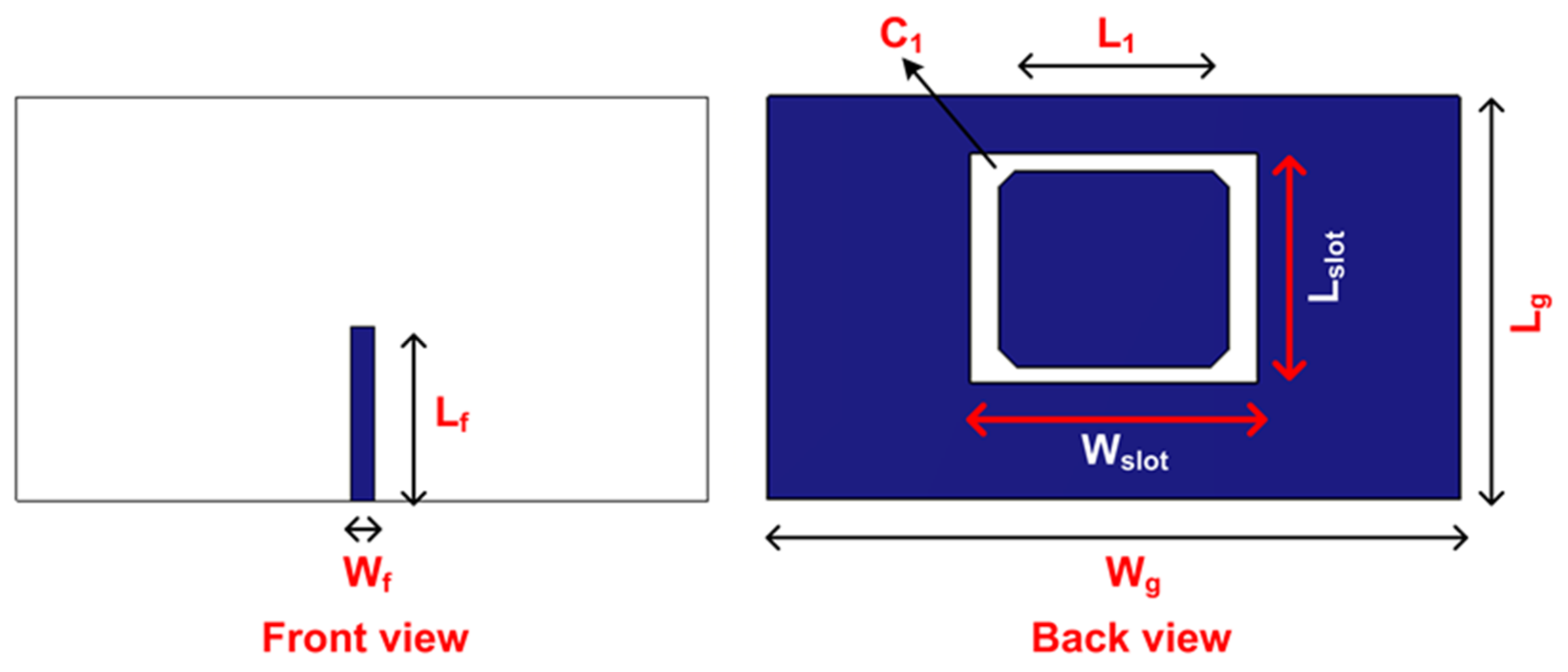
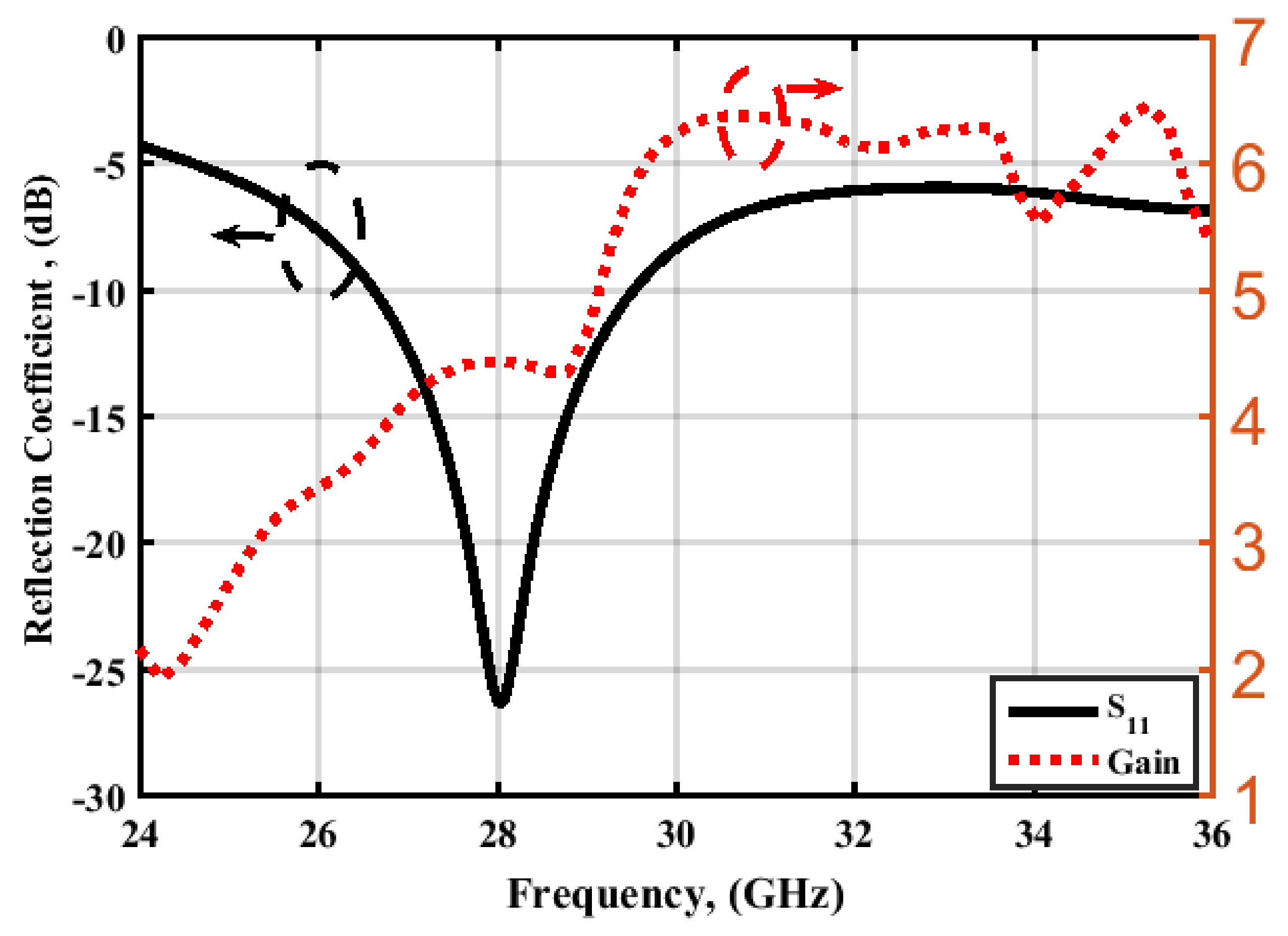
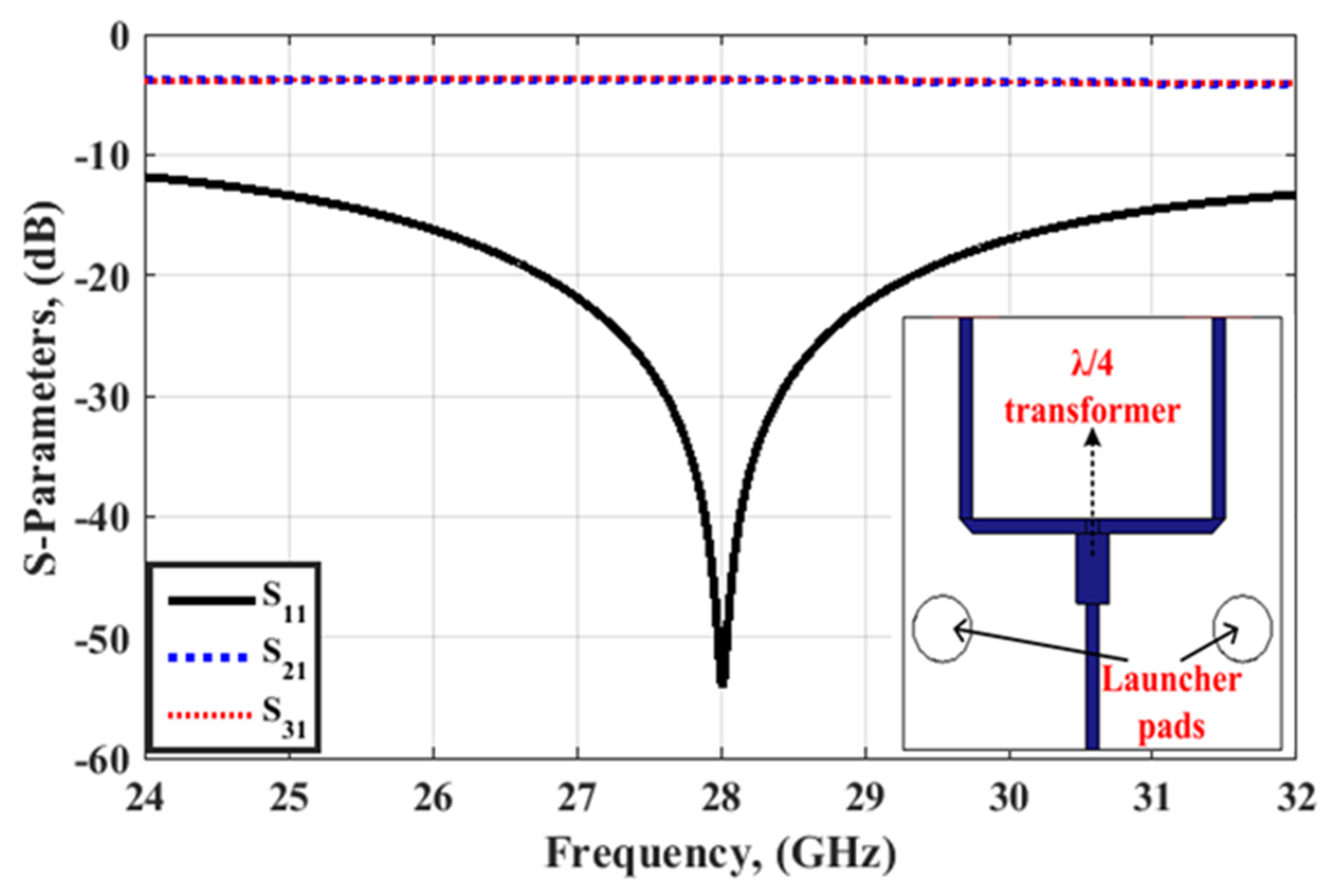
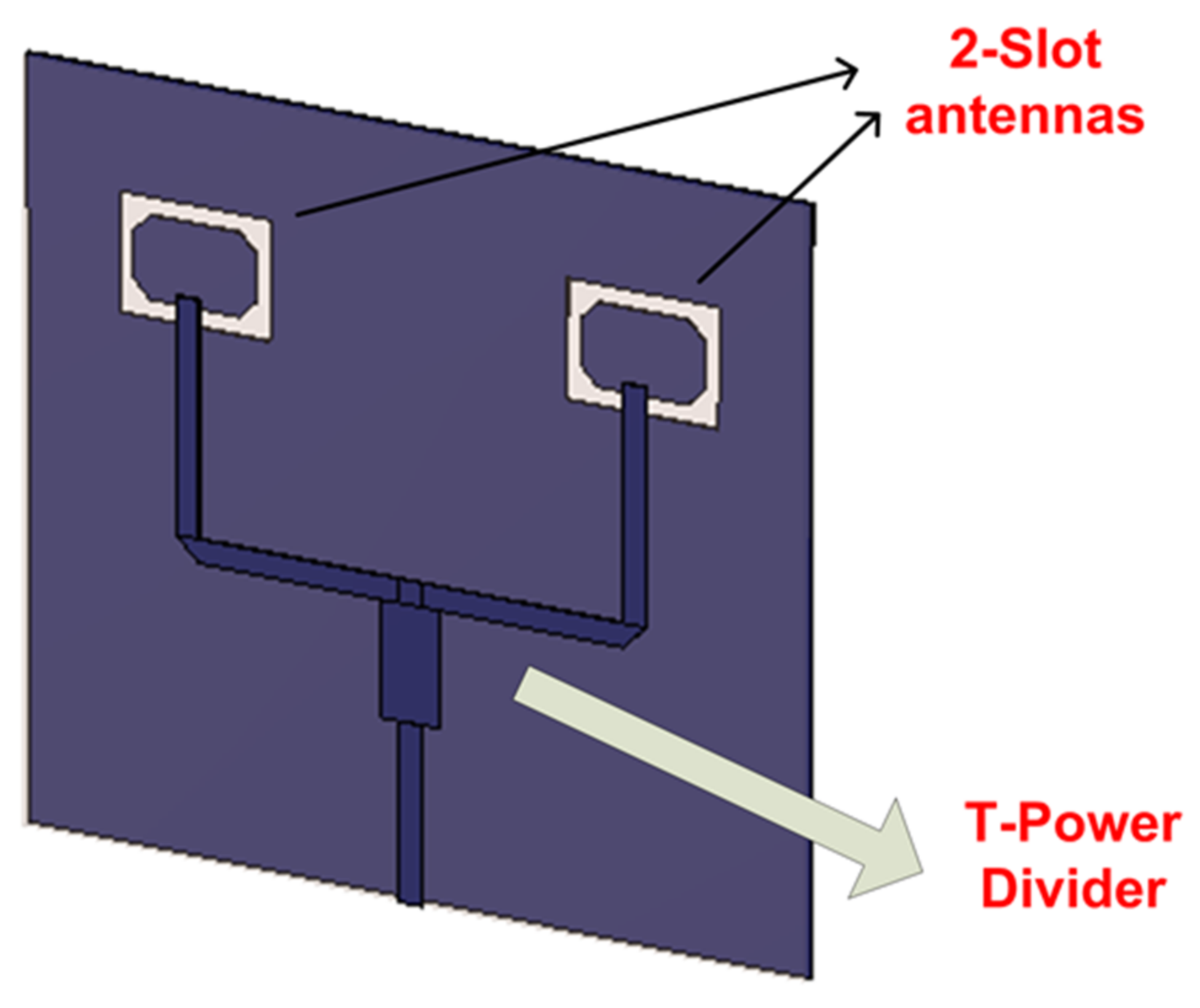
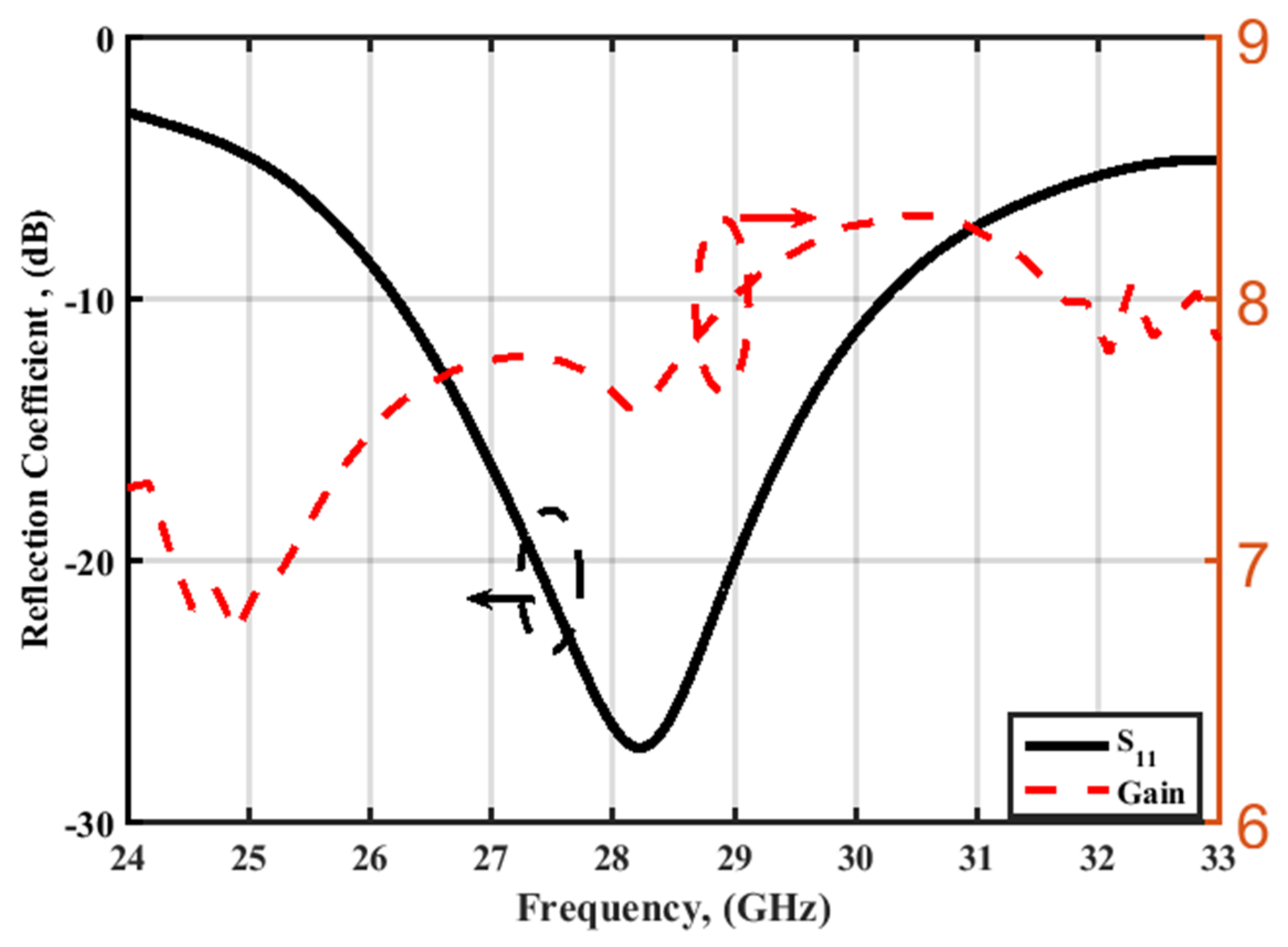
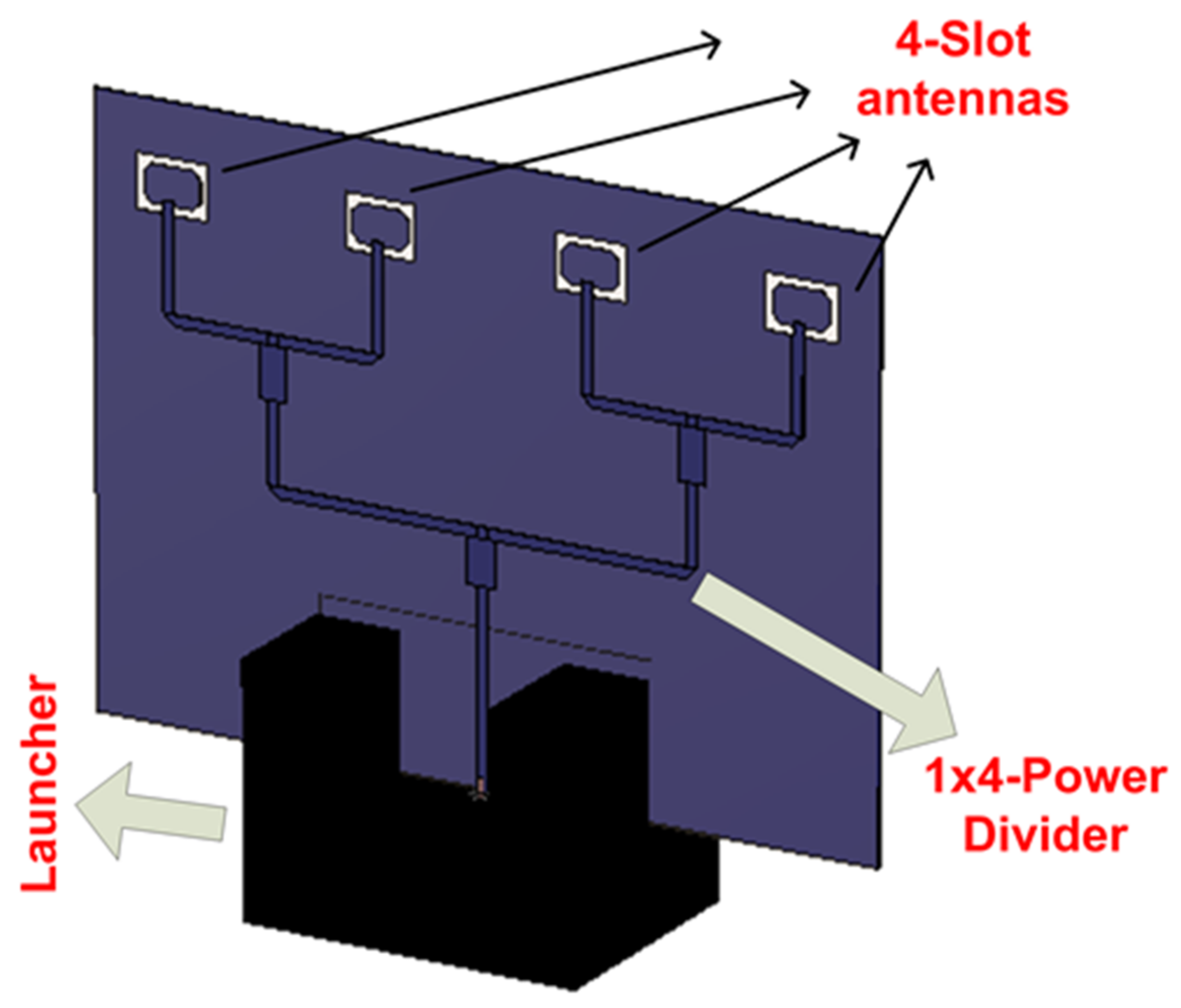

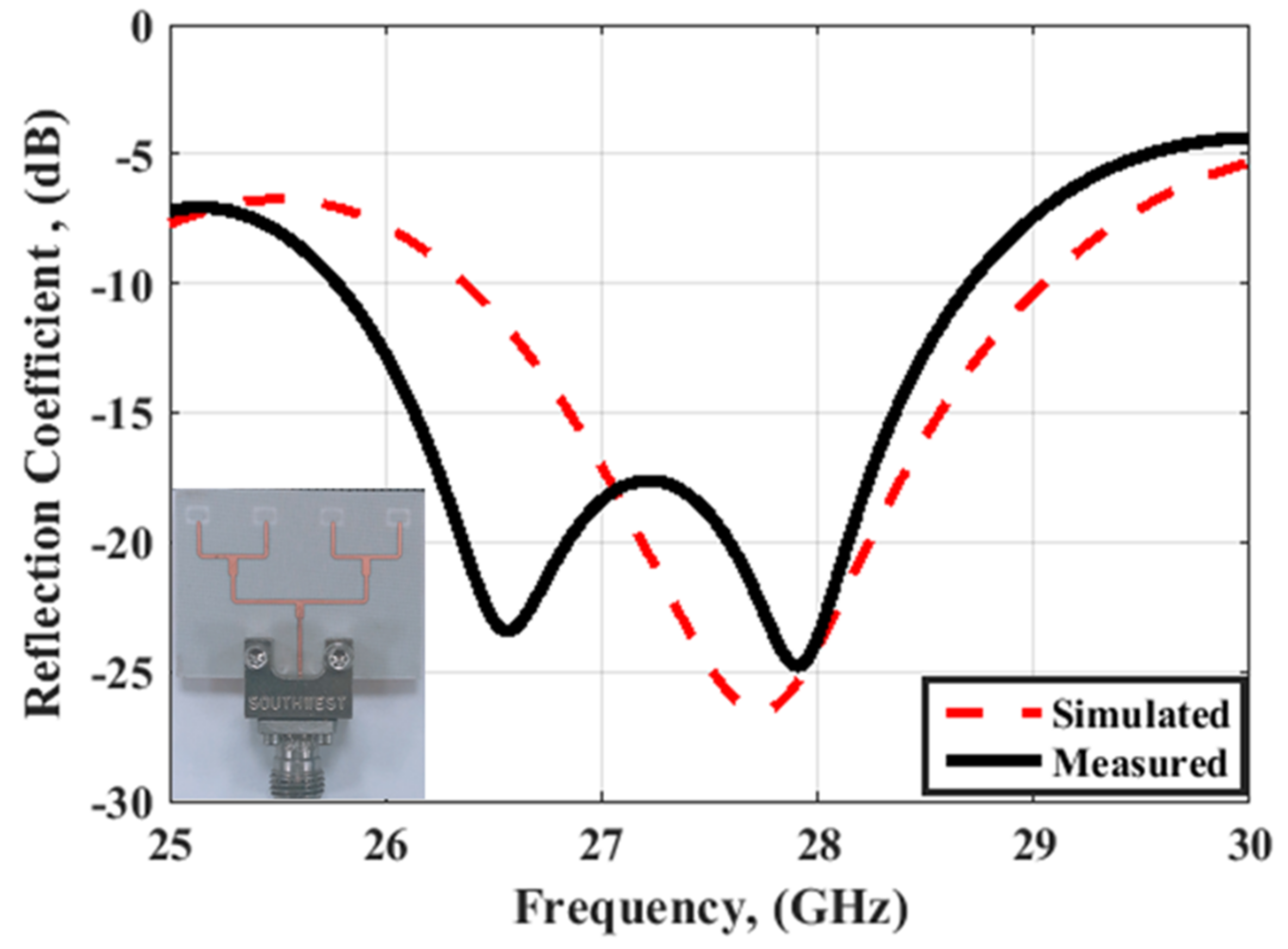
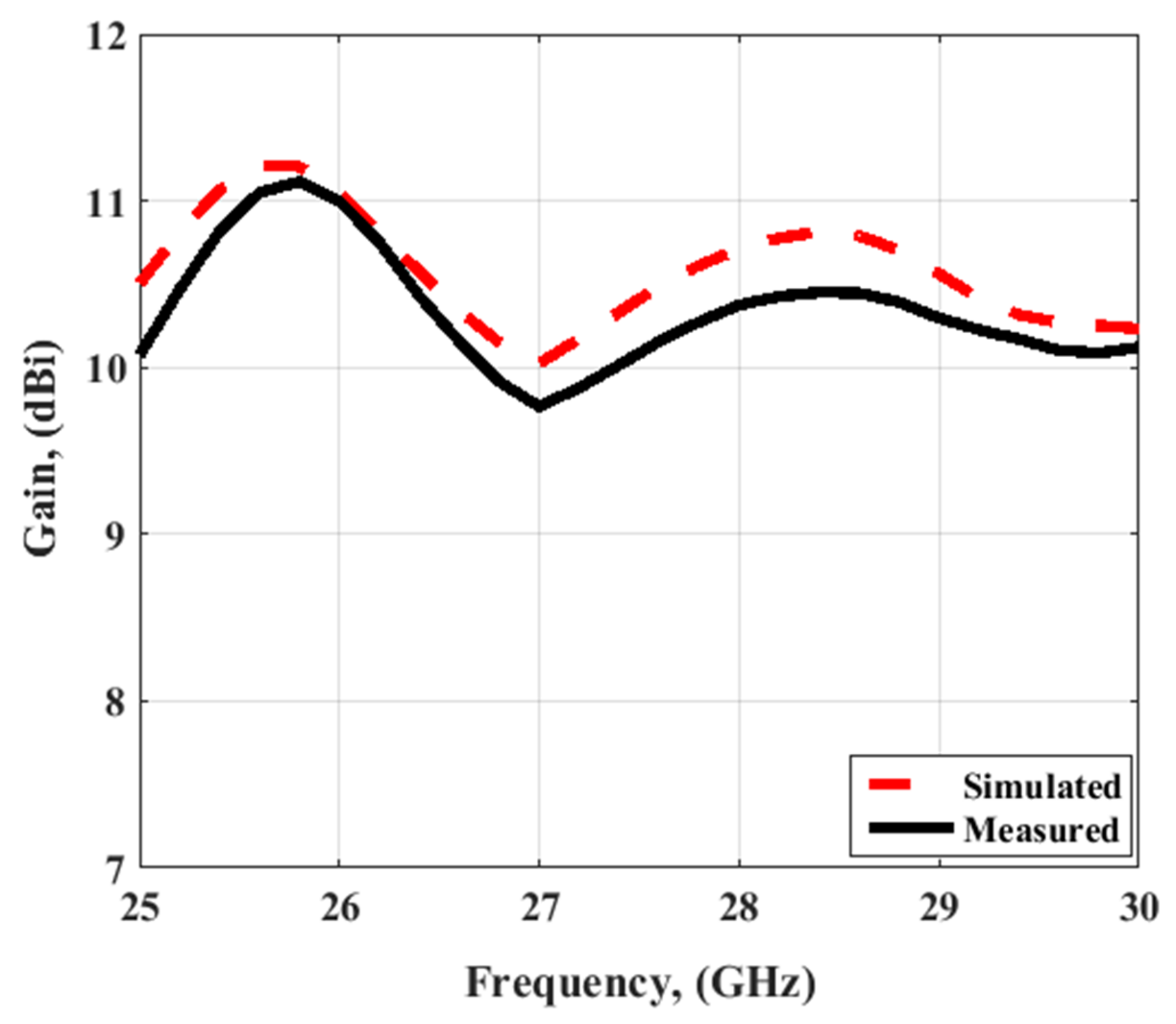
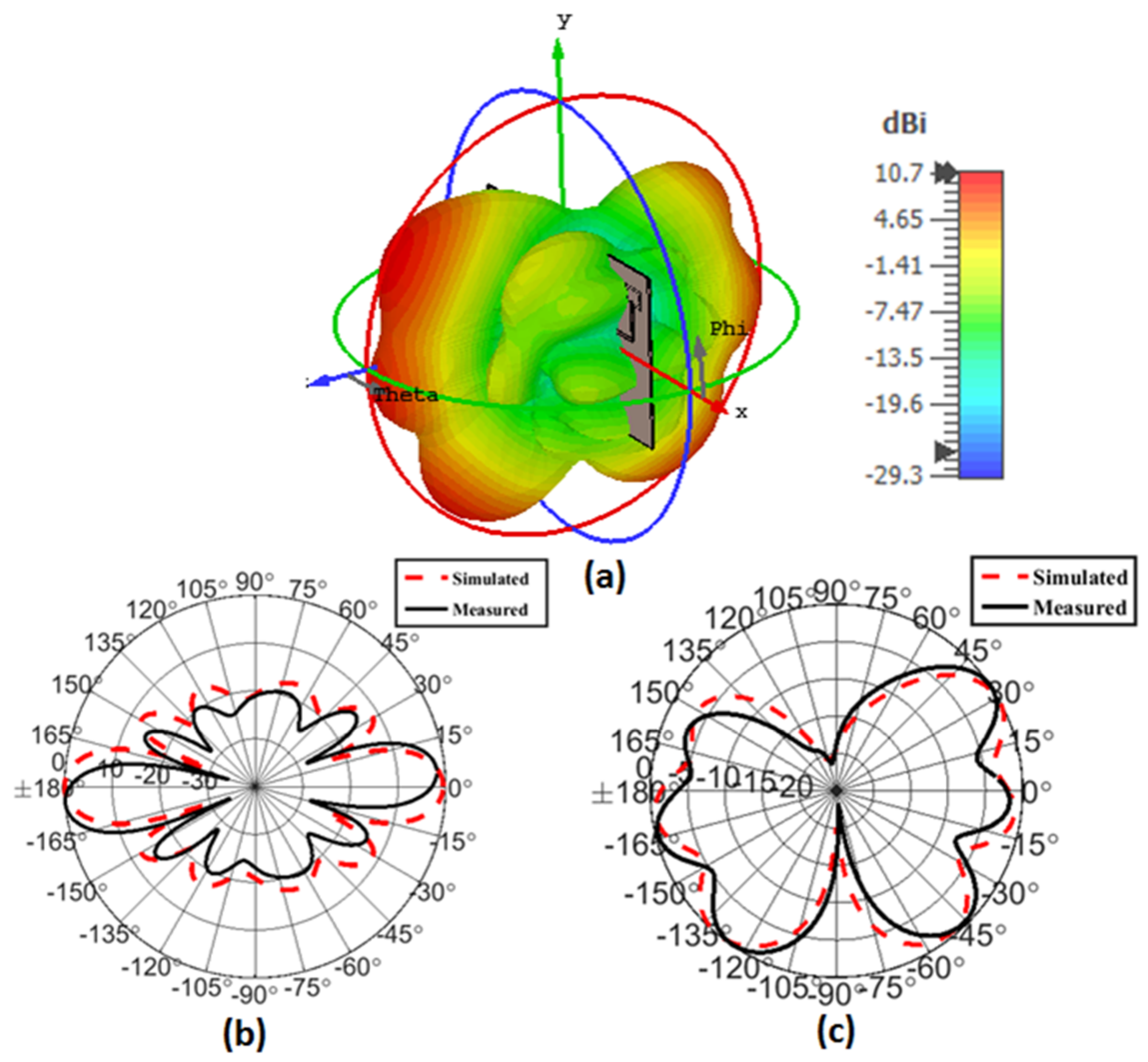

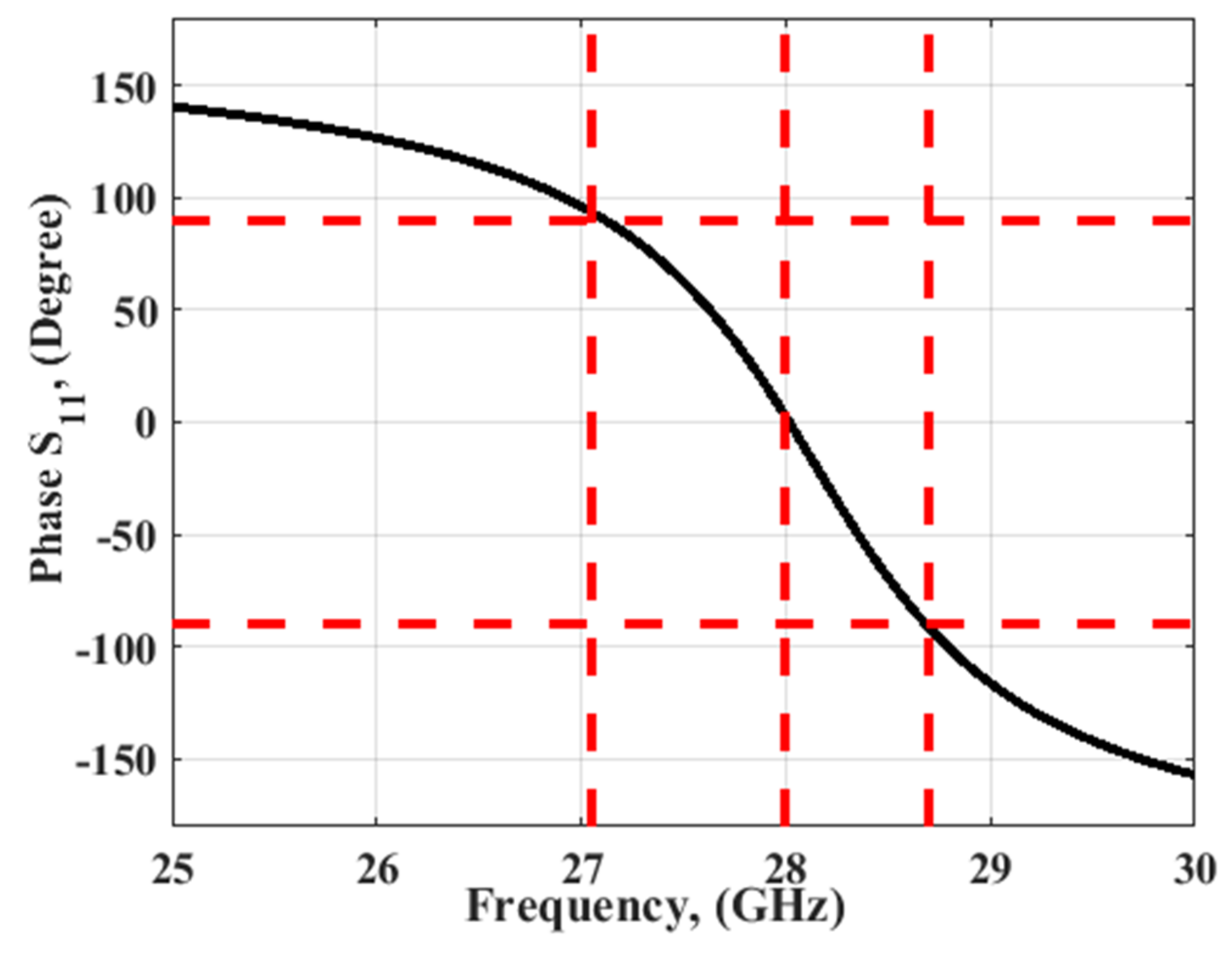
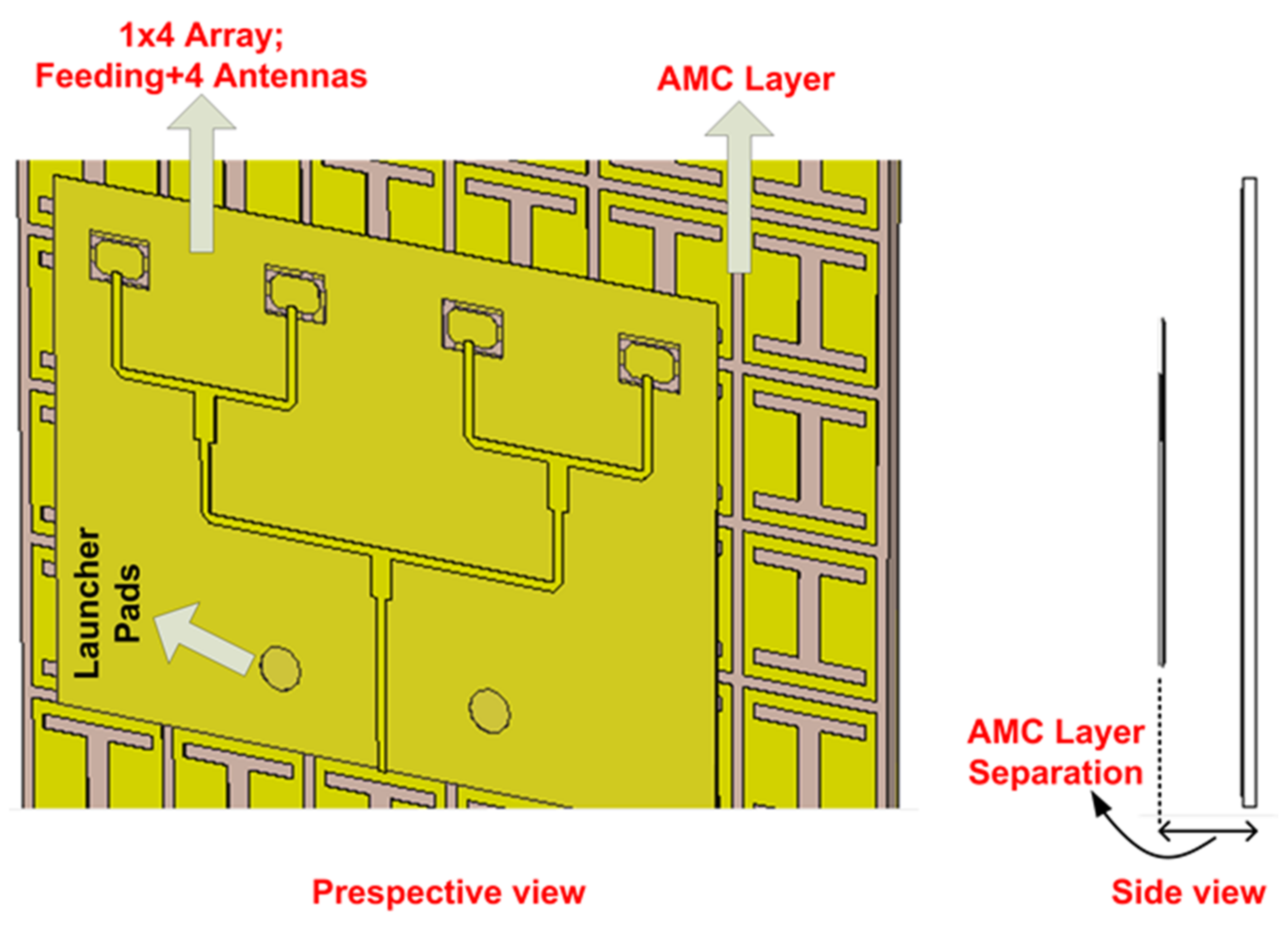
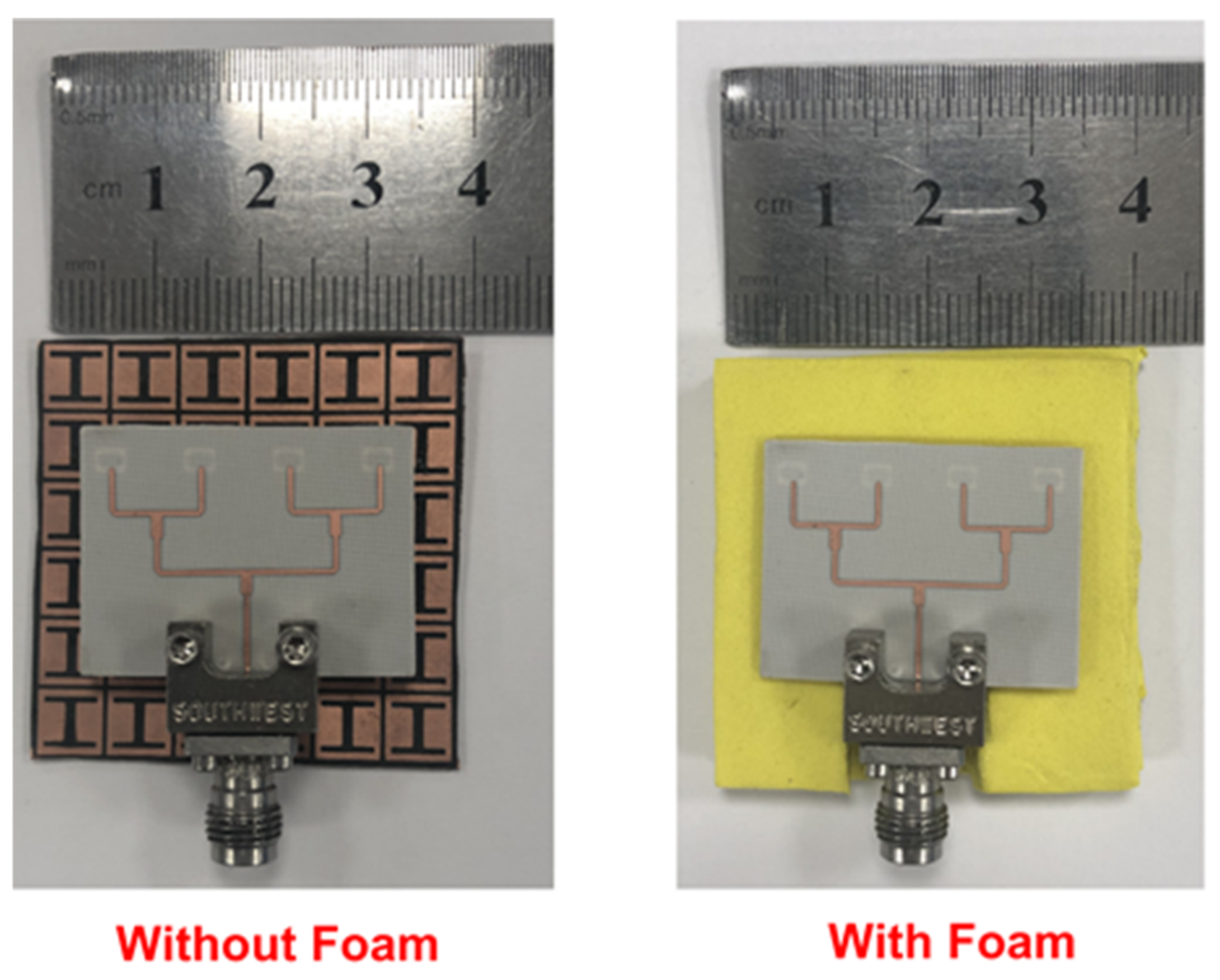
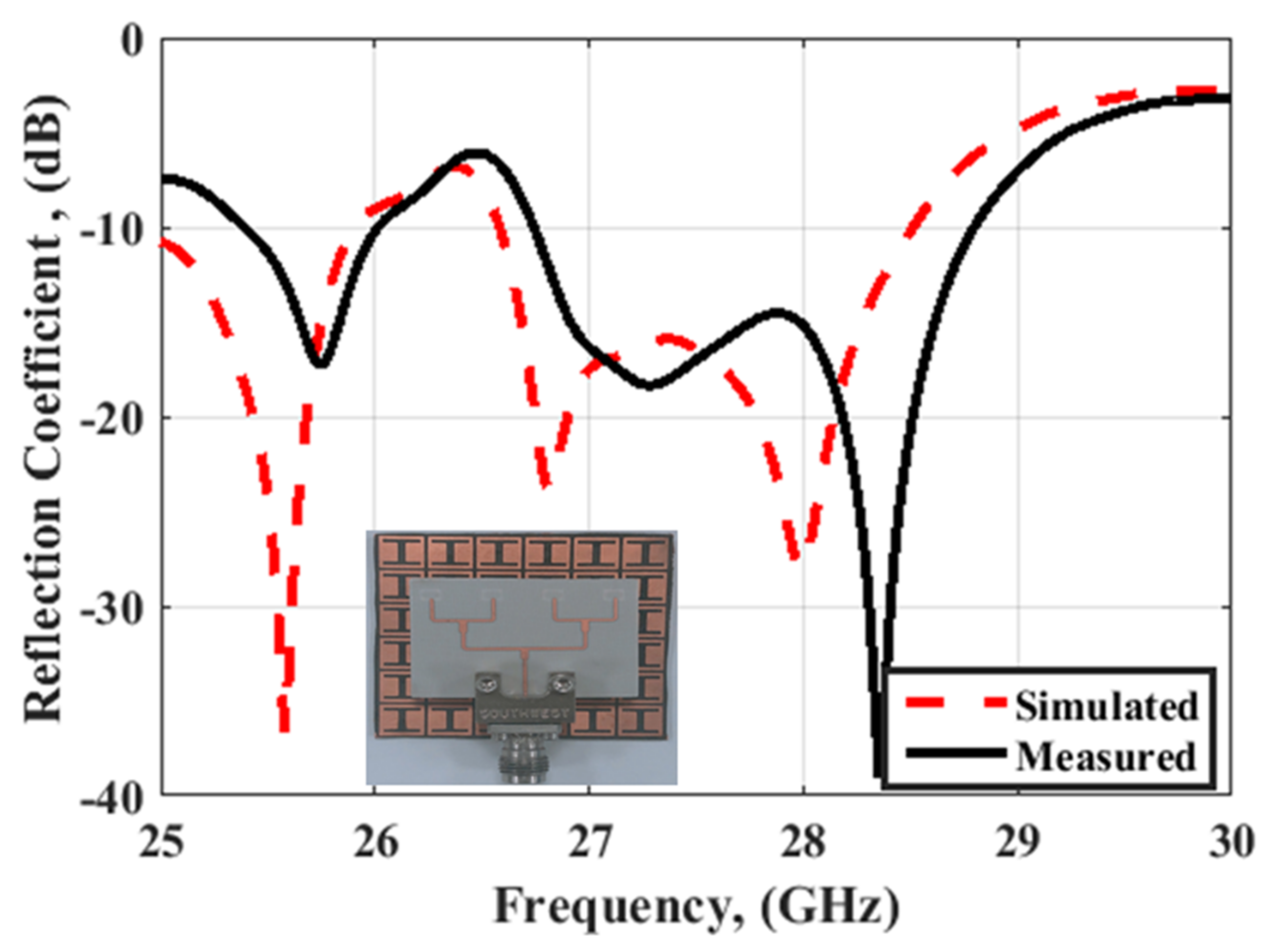
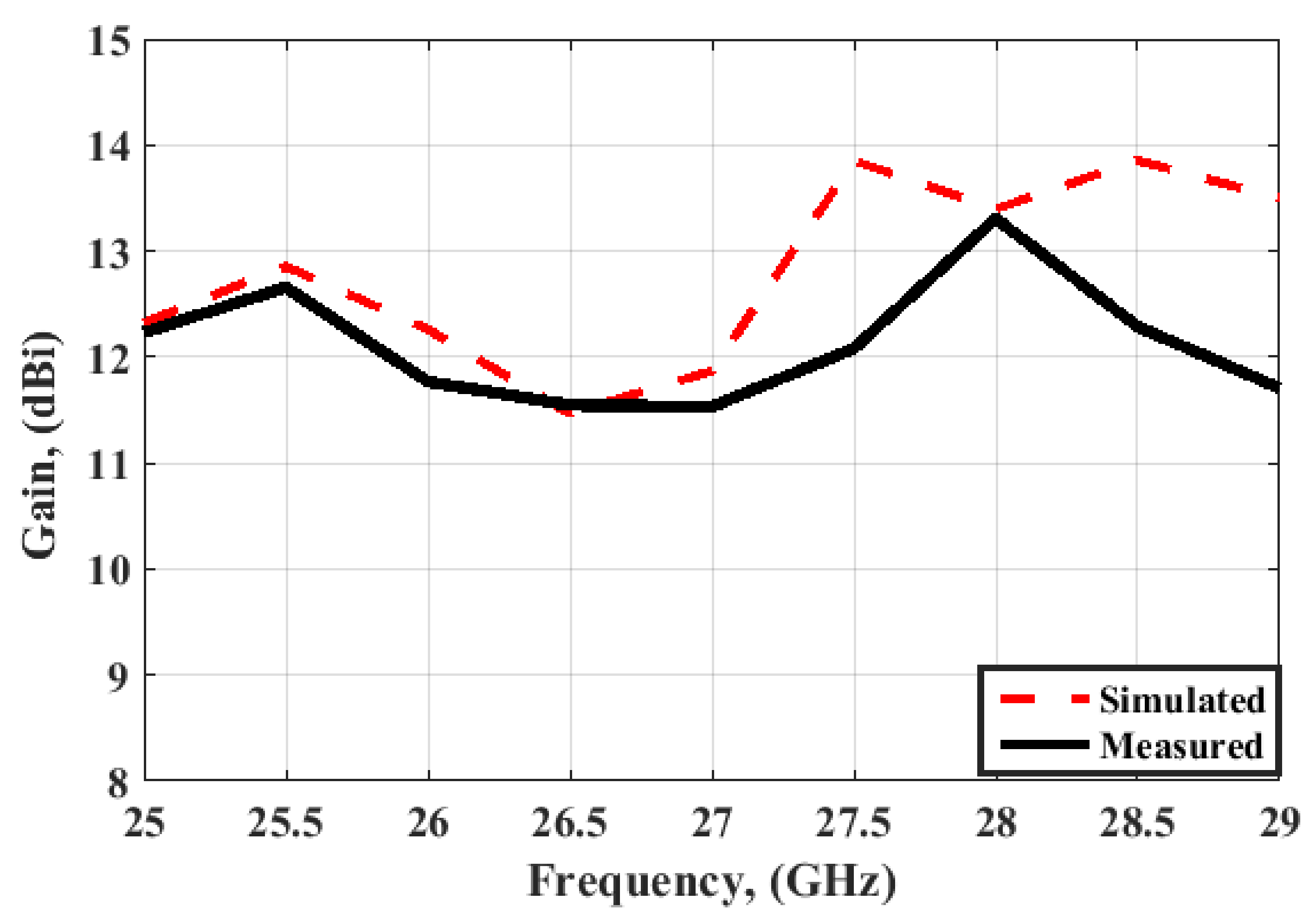

| Ref. | Matching Level (dB) | f0/BW (GHz) | No. of Array Elements | Gain (dBi) | Radiation Efficiency (%) | Substrate εr /Thickness (mm)/ AMC Gap (mm)/ Thickness (mm) | Circuit Size (mm × mm) | Circuit Size (λg × λg) |
|---|---|---|---|---|---|---|---|---|
| [9] | 20 | 28/5 | 2 | 10 | 91 | 3.55/0.203/4.7/0.203 | 47 × 47 | 8.3 × 8.3 |
| [12] | 22 | 28/4 | 8 | 12.7 | 71.45 | 3.5/0.2/-/- | 75 × 150 | 13.1 × 26.2 |
| [13] | 24 | 28/3.66 | 5 | 10 | 92 | 4.3/1.6/-/- | 30 × 19 | 5.8 × 3.7 |
| [14] | 20 | 32.5/11.5 | 8 | 12.5 | NA | 2.2/0.254/-/- | 45 × 45 | 7.2 × 7.2 |
| [20] | 28 | 30/1.06 | 1 | 9.2 | NA | 3/0.254/4.6/0.787 | 17.3 × 17.3 | 2.9 × 2.9 |
| [21] | 20 | 33/7 | 1 | 5.5 | 66.5 | 2.2/0.8/-/- | 30 × 16 | 4.9 × 2.6 |
| [22] | 25 | 30.8/5.7 | 1 | 7.8 | 80 | 3.66/0.5/-/- | 12.8 × 12.8 | 2.5 × 2.5 |
| [27] | 17 | 28/1 | 4 | 12.02 | 82 | 2.2/0.787/-/- | 30 × 35 | 2.8 × 3.26 |
| [28] | 22 | 28/4.1 | 4 | 8.3 | 80 | 3.66/0.76/-/- | 30 × 35 | 2.8 × 3.26 |
| [29] | 36 | 28/2 | 4 | 6.1 | 92 | 2.2/0.787/-/- | 30 × 30 | 2.8 × 2.8 |
| This work (without AMC) | 25 | 28/2.91 | 4 | 10.3 | 94.4 | 3.55/0.203/-/- | 30 × 22.1 | 5.3 × 3.8 |
| This work (with AMC) | 27 | 28/3.1 | 4 | 13.01 | 83.05 | 3.55/0.203/4.7/0.787 | 39.5 × 39.5 | 6.9 × 6.9 |
Publisher’s Note: MDPI stays neutral with regard to jurisdictional claims in published maps and institutional affiliations. |
© 2022 by the authors. Licensee MDPI, Basel, Switzerland. This article is an open access article distributed under the terms and conditions of the Creative Commons Attribution (CC BY) license (https://creativecommons.org/licenses/by/4.0/).
Share and Cite
Ibrahim, A.A.; Zahra, H.; Dardeer, O.M.; Hussain, N.; Abbas, S.M.; Abdelghany, M.A. Slotted Antenna Array with Enhanced Radiation Characteristics for 5G 28 GHz Communications. Electronics 2022, 11, 2664. https://doi.org/10.3390/electronics11172664
Ibrahim AA, Zahra H, Dardeer OM, Hussain N, Abbas SM, Abdelghany MA. Slotted Antenna Array with Enhanced Radiation Characteristics for 5G 28 GHz Communications. Electronics. 2022; 11(17):2664. https://doi.org/10.3390/electronics11172664
Chicago/Turabian StyleIbrahim, Ahmed A., Hijab Zahra, Osama M. Dardeer, Niamat Hussain, Syed Muzahir Abbas, and Mahmoud A. Abdelghany. 2022. "Slotted Antenna Array with Enhanced Radiation Characteristics for 5G 28 GHz Communications" Electronics 11, no. 17: 2664. https://doi.org/10.3390/electronics11172664
APA StyleIbrahim, A. A., Zahra, H., Dardeer, O. M., Hussain, N., Abbas, S. M., & Abdelghany, M. A. (2022). Slotted Antenna Array with Enhanced Radiation Characteristics for 5G 28 GHz Communications. Electronics, 11(17), 2664. https://doi.org/10.3390/electronics11172664













